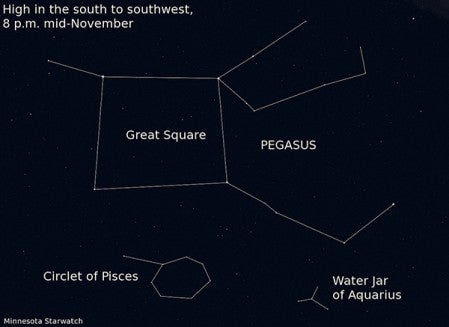Minnesota Star Watch
Published 8:34 am Sunday, November 2, 2014
By Deane Morrison
University of Minnesota
In November, Saturn and Venus trade places, and we get a meteor shower that could be worth the late hour.
 Saturn, an evening planet, is falling into the sun’s afterglow just as Venus is emerging from it. On the 13th the two planets cross paths, but all month long they are much too close to the sun to see. Saturn drops behind the sun on the 18th, at which moment it becomes, officially, a morning planet. Venus, a morning star for most of the year, passed behind the sun in late October, and now we can look forward to its reappearance as an evening star.
Saturn, an evening planet, is falling into the sun’s afterglow just as Venus is emerging from it. On the 13th the two planets cross paths, but all month long they are much too close to the sun to see. Saturn drops behind the sun on the 18th, at which moment it becomes, officially, a morning planet. Venus, a morning star for most of the year, passed behind the sun in late October, and now we can look forward to its reappearance as an evening star.
In the southwest, Mars, the fastest of the outer planets, still has a few more months in the evening sky. Not so the Teapot of Sagittarius; this month it slips behind Mars, tips its spout, and dips below the horizon, leaving the Red Planet bereft of bright company until next year, when Venus comes calling.
The Great Square of Pegasus is high in the south, moving into the southwest. Northeast of the Great Square, between it and the M- or W-shaped form of Cassiopeia, a faint oval smudge marks the Andromeda galaxy. The Milky Way’s closest large neighbor is now very nearly directly overhead, and November’s dark skies but not-quite-wintry temperatures make this a great time to see it. Binoculars will help.
November’s full moon rises around sunset on the 6th, less than an hour after reaching perfect fullness. This beauty is the full beaver moon, named for the busy rodents now preparing their lodges for winter.
King of the morning, Jupiter rides high and brilliant in the south at dawn, above the bright star Regulus, in Leo. As Earth gains on the giant planet it rises earlier, and this month it begins coming up before midnight.
Jupiter has now put 90 degrees of sky between it and the sun, reaching a position called west quadrature. This is also the position occupied by the last quarter moon, and, as if on cue (but actually by coincidence), a last quarter moon appears below Jupiter the morning of the 14th. The moon reaches this precise phase at 9:16 a.m., just 12 hours after Jupiter does. But while this moon is waning and moving east, Earth’s motion is sweeping Jupiter west with the stars. In a few short months the king of planets will be 180 degrees from the sun and, like a full moon, up all night.
The peak night for the annual Leonid meteor shower will be the 17th-18th; try looking between 11 p.m. and 3 a.m., when no moon will interfere. Meteors will radiate from the east, in the Sickle of stars near Jupiter. Leonids are bright and often leave persistent trails, but this year the shower’s intensity is predicted to be closer to a light rain than a storm.
Standard time resumes at 2 a.m. on the 2nd. Set your clocks back an hour.
The University of Minnesota offers public viewings of the night sky at its Duluth and Twin Cities campuses. For more information and viewing schedules, see:
Duluth, Marshall W. Alworth Planetarium: www.d.umn.edu/planet
Twin Cities, Minnesota Institute for Astrophysics (during fall and spring semesters): www.astro.umn.edu/outreach/pubnight.
Check out the astronomy programs at the University of Minnesota’s Bell Museum ExploraDome: www.bellmuseum.umn.edu/ForGroups/ExploraDome/index.htm.
Contact: Deane Morrison, University Relations, (612) 624-2346,morri029@umn.edu
Find U of M astronomers and links to the world of astronomy athttp://www.astro.umn.edu.




